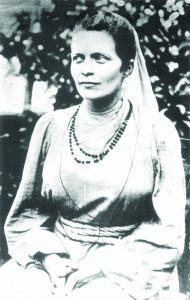The Story of Sister Nivedita, a Woman Who Knew That India’s Unity Was in Its Diversity
Nivedita added to the mantra of nation-making, which would set a direction and course to an awakened people in their ultimate movement towards freedom.

Nivedita was now driven by her mission of generating awareness
among Indians about the underlying oneness in their civilisational
experience, despite external disparities. It was a misconception to
think that the British, with English education, introduction of
cheap postage and building of a strong infrastructure of roads and
railways, had created India. The idea of India was to be propagated
by homegrown efforts and not foreign examples. In her expressive
words, Nivedita wrote, ‘It is not by imitation of foreigners, but by
renewed effort to self-expression—in other words, by movements of
national revival—that nations rise. History is ashirbad, the promise
that the nationality makes to each one of its children . . . History is
the warp upon which is to be woven the woof of Nationality.
Only in the mirror of her own past can India see her soul reflected and only in such vision can she recognise herself.’

The lessons of Pestalozzi and Froebel in the field of education,
which had formed a deep impression on Nivedita in her early days,
could be applied to all areas of development. In this, she had found
support for Vivekananda’s views of national development along
indigenous lines and now felt a great urge to articulate and elaborate
on this ideal. ‘The whole task now is to give the word “Nationality”
to India—in all its breadth and meaning,’ she explained. India must be observed by this great conception. Hindu and Mohammedan must become one in it with a passionate admiration
of each other. It means new views of history, of custom, and it
means the assimilation of the whole Ramakrishna-Vivekananda
idea in Religion—the synthesis of all religious ideas. It means a
final understanding of the fact that the political process and the
economic disaster are only side-issues, that the one essential fact
is realisation of her own Nationality by the Nation.
These thoughts, with which she found herself ‘bubbling over’,
found powerful expression in her significant book The Web of Indian
Life. Her great satisfaction lay in the realisation that ‘it is not my
book at all, but Swamiji’s, and my only hope about it is that I may
have said the things He would have liked said’.
Ever since her arrival in India in 1898, Nivedita had slowly
come to identify with the inner cry of its people. Her stay in a
conservative Bengali locality, interaction with residents during
plague, advocacy of education to girls and women, extended travels
around the country, some with Swamiji and some in the course
of her lectures, had given her a rare insight into the vastness of
India and its cultural differences. But she could also see from the
distanced, broader perspective of a Westerner the fundamental
pattern of unity that lay below the surface of diversity. With a
compassionate mind, she sought not to critique but to understand
the societal and religious structure that bound the country. At the
same time, she drew on her own knowledge and experiences of
Western society to make relevant analogies placing her observations
in context. Nivedita acknowledged that Prof. Geddes had taught
her to understand Europe and indirectly given her a method by
which she could also read her Indian experiences. In the six word
sequence of Place-Work-Family-Ideals-Thoughts-Action
used by Geddes in his social analysis resulting in a synthesis of
knowledge, Nivedita detected ‘enough dynamite to make a nation’. Geddes had recognized Nivedita’s keen vision and sympathetic and
spiritual insight. Far beyond the simple underlying canvas of its
material conditions, Nivedita could discern India’s rich and varied
embroidery. According to her, there was a fundamental unity,
which through centuries had been forged on folklore, mythologies,
music and shared history, but had remained unnoticed and
dormant. It was only by invoking this spirit of national unity that
the exploitative British rule could be challenged and vanquished.
As Nivedita put it, ‘The idea of Nationality will be the Sword
of India . . . She will have to be ready and willing to fight.’
Vivekananda had stressed on ‘man-making’, character building and
physical training, which would create an inner strength, shaking off
the diffidence and inertia of centuries. Nivedita added to this her
mantra of nation-making, which would set a direction and course to
an awakened people in their ultimate movement towards freedom.
In his introduction to The Web of Indian Life, Rabindranath
Tagore drew attention to the customary contempt and disparaging
remarks of Western commentators on India, which had sapped the
national morale. This ‘vast accumulation of calumny against India’
was the result of a superficial knowledge and a limited acquaintance
with Indian languages. Nivedita, on the other hand ‘had won her
access to the inmost heart of our society by her supreme gift of
sympathy. She did not come to us with the impertinent curiosity
of a visitor nor did she elevate herself on a special high perch with
the idea that a bird’s eye view is truer than the human view because
of its superior aloofness. She lived our life and came to know us
by becoming one of ourselves. She became so intimately familiar
with our people that she had the rare opportunity of observing us
unawares’. The Poet could recognise the sensitive understanding
of Nivedita and commented,
The mental sense, by the help of which we feel the spirit of a people,
is like the sense of sight, or of touch—it is a natural gift . . . those
who have no ear for music, hear sounds, but not the song . . . And
Sister Nivedita has uttered the vital truths about Indian life.”

Excerpted from Margot: Sister Nivedita of Vivekananda by Reba Som, with permission from Penguin Random House India’. You can buy your copy here.
Like this story? Or have something to share?
Write to us: [email protected]
Connect with us on Facebook and Twitter.
NEW: Click here to get positive news on WhatsApp!
If you found our stories insightful, informative, or even just enjoyable, we invite you to consider making a voluntary payment to support the work we do at The Better India. Your contribution helps us continue producing quality content that educates, inspires, and drives positive change.
Choose one of the payment options below for your contribution-
By paying for the stories you value, you directly contribute to sustaining our efforts focused on making a difference in the world. Together, let’s ensure that impactful stories continue to be told and shared, enriching lives and communities alike.
Thank you for your support. Here are some frequently asked questions you might find helpful to know why you are contributing?


This story made me
- 97
- 121
- 89
- 167











